Over 40,000 Miles, Our 2017 Subaru Impreza Is Unexciting, in Good and Bad Ways
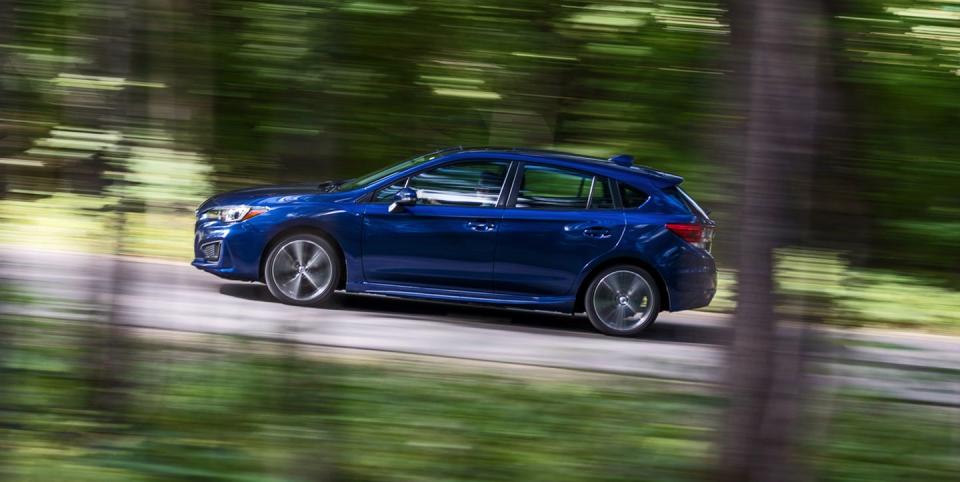
Despite its normcore looks, the Subaru Impreza has long found credibility in enthusiast circles thanks to its association with the rally-inspired WRX model. But the latest Impreza, which rides on the Subaru Global Platform, doesn’t have much to do with the World Rally Championship these days. In hatchback form, it now seems much more closely related to the Crosstrek quasi-crossover than the turbocharged WRX sedan, which is still based on the previous-generation Impreza and won't migrate to the new platform until the 2020 or 2021 model year.
Nevertheless, the Impreza had plenty to recommend it when it first arrived on our doorstep. Subaru promised this new platform would improve the model’s ride and handling compared with that of previous generations. A manual transmission is still standard, although we chose the more popular continuously variable automatic (CVT) for our test. This small hatchback, with 21 cubic feet of cargo space, rivals the hauling ability of some SUVs. And the standard all-wheel drive served us well when our first weekend with the Impreza brought a late-season snowstorm.
With all those marks in its favor, the Impreza made a strong first impression. Our Sport-trim example came with brake-based torque vectoring and 18-inch wheels (lesser models make do with 16s), and early comments praised the Impreza's firm ride and accurate steering. The CVT earned accolades for its convincing imitation of a traditional automatic. During the break-in period, before we probed the upper limits of the tachometer, we were impressed with the Impreza's strong initial throttle response.
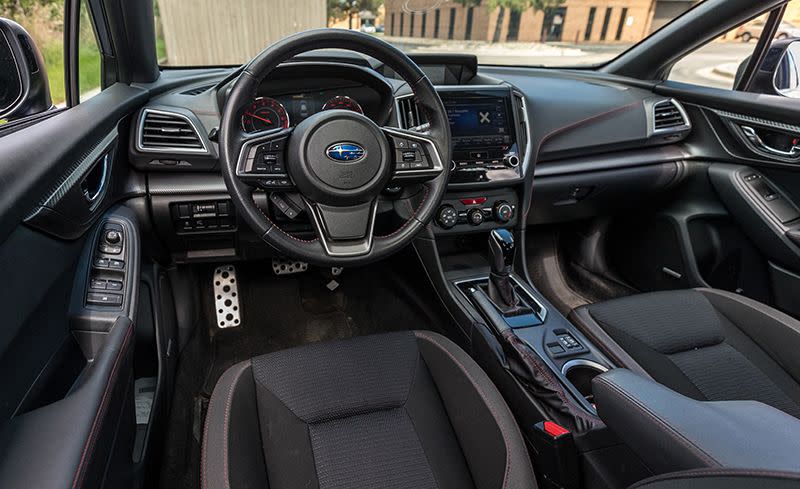
The adaptive-cruise-control system (part of a $2945 package that also includes automated emergency braking, lane-departure warning, a sunroof, and an eight-speaker audio system) earned our seal of approval. Associate online editor Joseph Capparella called the system "intuitive" after a trip to Ohio, adding that it "never reacts abruptly." This stood in contrast to our contemporaneous long-term Honda Civic, in which the adaptive cruise drew complaints for approaching other vehicles too quickly, applying the brakes too hard, and allowing too large a gap between itself and the car ahead. The Subaru's lane-departure warning, however, annoyed us with its loud and frequent beeping.
Excitement began to fade once the Impreza's break-in period elapsed. Free to explore the car's full performance range, we found that there wasn't much we hadn't already discovered. The run to 60 mph took 9.1 seconds, and the Impreza's 170-foot stop from 70 mph was similarly mediocre. Its 0.84 g of skidpad grip trailed not only that of our long-term Civic but also that of our previous long-term Impreza, a 2012 hatchback that notched 0.85 g in the same test.
Perhaps that explains why, after trips to Virginia and southern Ohio in the first few months of its stay, the Impreza was largely relegated to commuter duty through much of the busy summer road-trip season. Drivers who did take the Impreza farther afield remained impressed by the cavernous cargo hold but bemoaned the car's need for constant steering corrections on the highway and its sub-30-mpg average fuel economy.
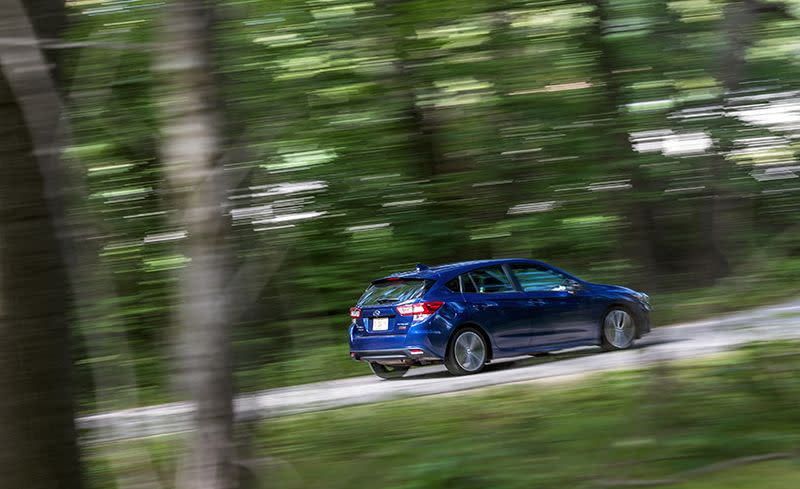
Once the Impreza rounded the halfway mark in its 40,000-mile journey, more negative logbook comments appeared. One author criticized the weak headlights, another decried the lack of wheelspin in the snow (though Subaru's more temperate clientele may count that as a benefit), and many complained that the Impreza was too slow. As assistant technical editor Maxwell Mortimer put it: "The phrase ‘pedal to the metal’ usually refers to enjoyable, spirited driving. However, in the Impreza, it refers to any time one needs any sort of meaningful acceleration."
Our Impreza may not have thrilled us, but its service record was nearly impeccable, requiring very few unscheduled trips to the dealer. At 26,000 miles, the driver's seatback began to rock back and forth. After diagnosing a loose connection between the seat-bottom frame bushings and the seat rails, the dealer ordered replacement parts and installed them free of charge. A month later, an obnoxious humming noise was resolved when the dealer determined the left-rear wheel bearing was worn out and replaced it. Aside from a bent wheel ($274) and some scrapes that needed mending just before the Impreza was sent away ($997), there were no other issues to speak of.
The Impreza's record was clean during its stay with us, but its total service cost ($652) was more than the Civic's. The Subaru's service visits were only about $10 more expensive on average than the Honda's, but the Impreza's 6000-mile service intervals meant that it made more trips to the dealer during its stay with us compared to the Civic, which has a 10,000-mile interval.
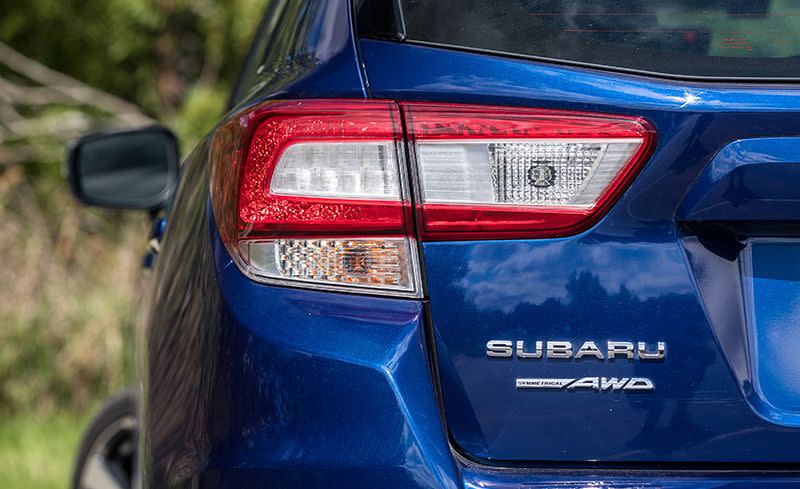
When it finally left our offices for good, 18 months after it had arrived, the Impreza was not mourned. Not because anyone had detested it, but because many editors had simply ceased to think of it at all. And it was never the first choice for road trips.
Boring may be the enemy of the auto journalist, but it's exactly what many buyers want. So while we can't truthfully say that we'll miss the Impreza, we can wholeheartedly recommend it to shoppers who are looking for a car that is reliable, versatile, and relatively affordable. We hear there's a nice one on the market, lightly used with all its records in order. Only 30 previous drivers.
Months in Fleet: 18 months Current Mileage: 40,261 miles
Average Fuel Economy: 28 mpg
Fuel Tank Size: 13.2 gal Observed Fuel Range: 370 miles
Service:$652 Normal Wear: $0 Repair: $0
Damage and Destruction: $1271
WHAT WE LIKE: Just over a year into our test of the Subaru Impreza, the 30,000-mile malaise has set in, and positive logbook comments have grown few and far between. What praise there is has, at least, been consistent. Way back at 12,000 miles, associate online editor Greg Fink declared the Impreza’s Starlink system “seriously one of the best touchscreen infotainment systems in the business.” While 18,000 miles later the bloom has fallen off the rose for many editors, Fink stands firm. “Is there a better overall infotainment system available today?” he ponders. His affection is not misplaced: The Impreza’s touch controls are large and easy to pinpoint while driving, and the menu setup is simple. It even did well in our test of touchscreen response times, earning a Good rating while several competitors managed only Poor.
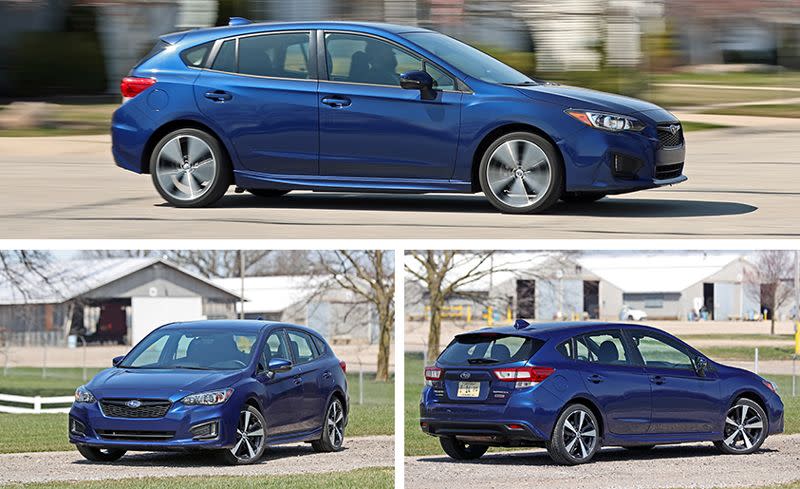
We like driving much better than we like fiddling with even the best touchscreens, however, and after a particularly snowy Michigan winter we can now faithfully attest to this Subie’s prowess when the going gets slippery. Buyer’s Guide senior editor Rich Ceppos drove the Impreza to Wisconsin during a snowstorm and came away impressed by the unflappability of Subaru’s famous all-wheel-drive system abetted by a set of excellent Michelin X-Ice winter tires. This steely confidence in the face of adversity has become Subaru’s hallmark of late; it’s not unusual to hear Michiganders in search of a new car say that a Subaru is the only brand they will consider. Never mind that virtually any all-wheel-drive car—or two-wheel-drive car, for that matter—with decent winter tires and functional ABS and traction-control systems would perform similarly well. Safety in bad weather is now a cornerstone of the Subaru mystique, and after what seemed like an interminable winter regularly punctuated by blizzards or blizzard-like events, we can’t argue with owners’ sense of security. The Impreza is entirely unshakable in inclement weather. Which brings us to . . .
WHAT WE DON’T LIKE: The Impreza is too good in the snow. Or, rather, not good enough at playing in the snow. Here’s some more context from Ceppos’s Wisconsin adventure: “It’s virtually impossible to have any fun behind the wheel of the Impreza, even on snow. You can do full-throttle launches on the white stuff with no wheelspin. Ugh.” That “ugh” was echoed by Josh Jacquot, reviews editor and owner of a Subaru Impreza 2.5 RS race car, who took our Impreza to a snowy cul-de-sac in hopes of ripping off a few donuts and came away dejected after his young daughter said that she had preferred the previous week’s joyride in an Audi A4.
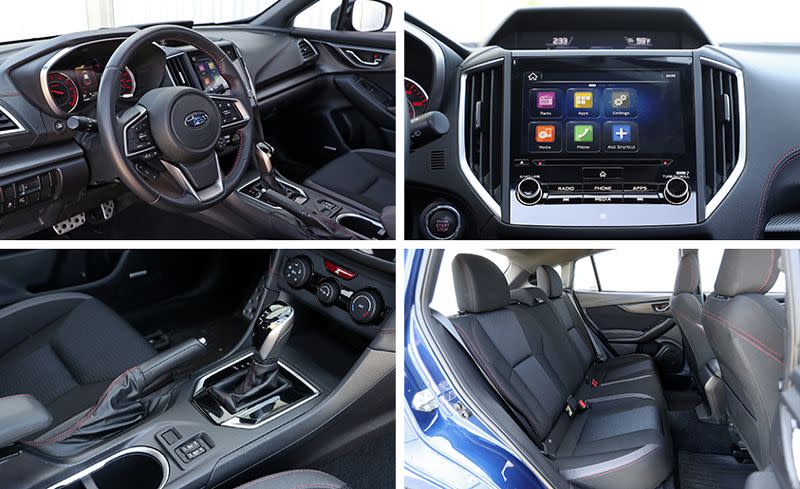
WHAT WENT WRONG: After 11 almost entirely trouble-free months, the Impreza has begun to feel the effects of age. At around 26,000 miles, people began to notice a slight rocking in the driver’s seat. A trip to the dealer validated our concerns, and the seat-bottom assembly and both driver’s-side seat rails were replaced under warranty. Shortly after the seat was fixed, a high-pitched whining noise developed. One driver thought the sound was coming from the HVAC fan motor, another referred to it as unspecified “driveline noise,” but virtually everyone who drove the Impreza during this period complained. A trip back to the dealer showed a worn wheel bearing in the left-rear wheel. The dealer had the parts on hand and seemed somewhat less than surprised to discover the problem, which was fixed under warranty. In the time since our last update, the Impreza has also had two oil changes, a tire rotation, and received new cabin and engine air filters as part of its regularly scheduled maintenance, which cost $119 for one visit and $108 for the other. And we ditched the winter tires for Yokohama all-seasons in late February, just in time for a late-season snowstorm to drop several more inches of heavy snow on the upper Midwest. Yes, the car did fine.
WHERE WE WENT: Winter makes homebodies of us all, and the Impreza hasn’t traveled far afield since it returned from its sojourn in Montana. Trips to Wisconsin, northern Indiana, and Ohio helped add miles, but we look forward to longer journeys as summer road-trip season approaches.
Months in Fleet: 14 months Current Mileage: 30,830 miles
Average Fuel Economy: 28 mpg Fuel Tank Size: 13.2 gal Fuel Range: 370 miles
Service: $380 Normal Wear: $0 Repair: $0
WHAT WE LIKE: We’re eight months and halfway through our Lapis Blue Subaru Impreza’s 40,000-mile marathon. The Impreza’s low beltline and generous sightlines tend to compensate for the car’s low stance. Brake feel is good, if a little aggressive at first hit, and the steering is also appropriately weighted and accurate, with excellent on-center feel. (The car is, however, no portrait of liveliness.) Also drawing favorable comments, the Impreza’s adaptive cruise control is subtle but vigilant, closely matching what would have been the driver’s own reactions.
When this hatchback’s rear seats are flattened, the cargo bay is beyond generous. Items 60 inches long—even a little north of that—will slide into the Impreza’s maw. Outdoorsmen intending to sleep back there will be disappointed, but if you bend your knees you could pull it off for an uncomfortable night or two. Well, one. One would be better.

The ride/handling trade-off shows evidence of conscientious engineers at work, with the car remaining flat and composed in all but the most spirited driving. There is a level of impact harshness, however, that borders on flinty, likely the result of those low-profile tires that look like rubber bands wrapped around thimbles. On the topic of ride, most logbook comments lean toward the favorable, but it varies with the quality of road surfaces. Moreover, the front tires can wander distractedly when road surfaces become, shall we say, scrofulous.

 Yahoo Autos
Yahoo Autos 